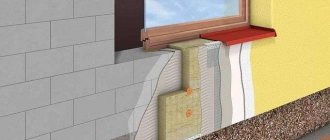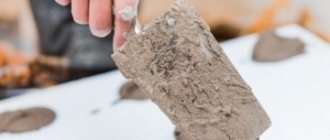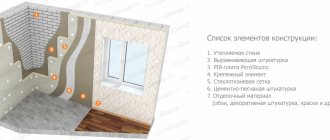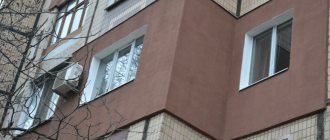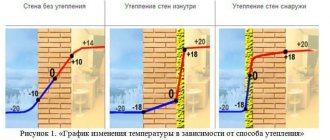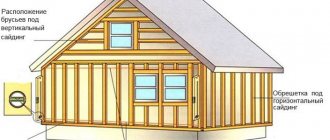Production and technical characteristics of glass wool
The same components are used for production as in glass production: limestone, borax, sifted sand, dolomite, soda. Most manufacturers replace raw materials with glass cullet (up to 80%), which reduces the final cost and does not affect the quality of the product.
The production technology consists of several stages:
- The components (broken glass products, fillers) are immersed in a hopper and fused at a temperature of 1400°C.
- The molten mass is inflated under the influence of steam.
- Polymers are added to form threads.
- The fibers are directed to leveling rolls, which form a kind of “carpet” of fiberglass.
- Polymerization at 250°C. The remaining moisture evaporates, the material cools down and becomes yellowish.
- After cooling under natural conditions, the fiberglass is sent for pressing and cutting to size.
Production stages
The material is produced in slabs, mats, and rolls. Each manufacturer determines the dimensions of the slabs independently. The main parameters of insulation produced in rolls are presented in the table.
Roll sizes
The properties and characteristics are as follows:
- Thermal conductivity. Due to the fibrous structure, air is retained in the volume of the material, which ensures low thermal conductivity (0.039-0.047 W/m K.
- Sound absorption (35 to 40 dB). The fibers of the material do not contribute to the spread of vibrations and noise.
- Vapor permeability (0.6 mg/mh·Pa). According to this parameter, insulation has an advantage over other materials.
- Fire resistance. Before purchasing, many people doubt whether modern glass wool will burn? It can withstand temperatures up to 500°C, and under the influence of fire it begins to sinter smokelessly without the formation of hazardous substances.
- Moisture resistance. When partially immersed in liquid, the moisture absorption parameter is 15%.
- Biological inertia. Does not contribute to the development of fungal colonies, the appearance of rot, and is not interesting for rodents.
- Deformation stability. The insulation can be compressed 6 times without losing its properties, and after removing the load it straightens to its original volume.
- Density. Depending on the manufacturer, the parameter ranges from 11 to 25 kg/m3.
Glass wool has good characteristics
The process of external insulation of a house with glass wool
Often, owners carry out external insulation of the home. This is not only the most effective option, but also the most reasonable in every sense. The point is that during the insulation process we can also produce high-quality wall finishing. Accordingly, this will significantly improve the appearance of the home. At the same time, a wide variety of finishing materials can be placed on the basis of the insulation, from plaster and brick to plastic panels or wooden blocks.
Once again, it should be noted that in the process of creating insulation, the most important thing is caution. As already mentioned, glass wool is a fairly loose material that can be damaged at any time. If possible, of course, you need to contact specialists who could share some advice regarding specific repair work.
The process of external insulation of a house itself consists of several stages. In general, there is nothing new here. It should be noted that the processes of insulating a home using various thermal insulation materials are similar.
- At the very beginning, you need to prepare the wall for the main process. In this case, you need to clean the surfaces, if possible, remove the plaster, and also clean the wall. The surface should not have any depressions or bulges. Of course, the efficiency of using insulation directly depends on this.
- Now comes the turn of waterproofing. As mentioned earlier, water absorption is the weak point of glass wool. Accordingly, we need to do everything possible to prevent moisture or water from getting on the thermal insulation material. Often, waterproofing is a regular film that prevents moisture from penetrating into the porous insulation. You can attach waterproofing to the wood base of your home using a stapler. The joints between the film strips are hidden with tape. The most important thing is to make sure that not a single drop of water can penetrate the glass wool. In advance, you can carry out simple tests of insulation efficiency.
- Next, a base is created for attaching the glass wool. These are wooden blocks (often their profile is 50x50 mm) that need to be attached to the wall at a certain pitch. This step depends on the width of the insulating material. Accordingly, if we know the width of the glass wool roll, we need to subtract 3-4 cm from this value, and this is exactly the distance between the bars. This is necessary so that the insulating material fits tightly into the created cells. In this case, you should not go too far, as too narrow a space can cause damage to the glass wool. The bars are attached using self-tapping screws. It is advisable to check the verticality of the wood elements so that the thermal insulation is fixed exclusively at the desired angle.
- Now the most crucial moment is the installation of glass wool. In this case, we simply place unfolded rolls of insulating material between the bars. This process must be carried out from top to bottom. All this should be done carefully, since the risk of damaging the material is actually great. If you find any damage, you should get rid of the specific glass wool unit. It’s better to spend money on new material once again, but be sure that we are dealing with high-quality thermal insulation. Damaged glass wool may be completely ineffective, and it is for this reason that the cold can easily penetrate into the home. For additional fixation of glass wool, you need to have special dowels for thermal insulation at your disposal. They are ordinary fasteners, but with an original cap that can withstand the heavy weight of thermal insulation. After installing the glass wool, you need to cut off the excess part of the roll. Of course, you should cut a little less material so that it fits snugly into the created space. For this task you will need a construction knife.
- Next is a layer of vapor barrier. This is almost the same as the very first layer, but with some amendments. Despite its insulating function, this unique layer will allow the wall to “breathe” even despite all the features of the materials used. Also, moisture does not get on the glass wool, and, accordingly, will not reduce its effectiveness. The vapor barrier is attached to the wooden blocks using a stapler. Again, there will also be joints here that need to be hidden with tape.
The main process is completed, and now you need to create a quality finish. This process should be carried out as quickly as possible so that no external factors affect the position of the glass wool or other insulation components. Often, high-quality plaster is created on the basis of thermal insulation, which adds a little more efficiency to the use of thermal insulation materials.
_ _ _ _ _ _ _ _ _ _ _ _ _ _ _ _ _ _ _ _ _ _ _ _ _ _ _ _ _ _ _ _ _ _ _ _ _ _ _ _ _ _ _ _ _ _ _ _ _ _ _ _ _ _ _ _ _ _ _ _ _ _ _ _ _ _ _ _ _ _ _ _ _ _
Features of working with glass wool
Before you start working with insulation, you should remember: if handled carelessly, glass wool can be harmful to health. To minimize risks and protect yourself you need to:
- Carefully straighten the rolls or sheets, clean them from crumbling particles.
- Apply the adhesive composition, press the insulation to the surface, hold for several minutes. When insulating ceilings or walls, it is necessary to install additional fasteners, use lathing, or perform waterproofing.
- The use of special clothing and personal protective equipment (goggles, respirator, gloves) is mandatory.
- Upon completion of work, wash your hands and face thoroughly. The harm of glass wool lies in the fact that its fibers are practically not washed out of fabrics, so it is not recommended to reuse contaminated workwear.
If fibers get into the respiratory system or on the skin, you should consult a doctor, since it is impossible to alleviate the situation at home. Is working with glass wool harmful to health? Of course yes.
Important! The danger may include itching, bronchitis, exacerbation of chronic respiratory diseases, and an allergy to glass wool is not uncommon.
When laying, it is mandatory to use PPE.
Working with insulation is not difficult at all - it is easily cut to the required size using industrial scissors or a hand saw with fine teeth. Fiberglass wool can be laid with a slight overlap (up to 3 cm), and then the excess is compacted into the frame.
Features of glass wool
As stated above glass wool
- This is one of the inexpensive building materials. Since the cost is not high, it is made from industrial waste. About half of the raw materials are cheap components.
Glass wool consists of the following components: soda, dolomite, limestone, sand. The main component of Knauf glass wool and other brands is cullet. The production and components of glass wool have not changed for several decades, which means that the primary components are most suitable for it.
Advantages of glass wool
This insulation was widely used in our country during the Soviet years. Today glass wool is more improved and has the following advantages:
- Good thermal insulation properties
. A layer of this material of 50 millimeters can be equated to the thermal conductivity of brickwork 100 centimeters thick. - Moisture resistance
. Glass wool practically does not absorb moisture. - Ease of transportation
. The material is light and compresses well. Therefore, no special transport is required to deliver glass wool to the work site. - Non-toxic
. In the production process of this insulation, only clean materials are used, as for the production of ordinary glass. The heat insulator does not emit toxic compounds during operation and even during fire. - Fire safety
. Glass wool practically does not burn. - Resistance to microorganisms
. The material will definitely not become moldy, and insects or rodents will not live in it. - Low price of glass wool
. Insulation is an order of magnitude cheaper than many similar mineral fiber materials.
Insulation of walls from the inside in a private house using mineral wool
Before insulating the walls from the inside, it is necessary to secure the sheathing.
Mineral wool is a material that has good thermal insulation properties, is easy to install and durable.
It is necessary to lay mineral wool slabs between the sheathing boards in such a way that no gaps are formed.
- mineral wool is secured with nails and dowels (fungi);
- lay the material from bottom to top;
- The edges of the mineral wool are slightly pressed for a tighter fit.
After the insulation is securely fastened, a vapor barrier layer is laid on it.
Disadvantages of glass wool
Like other types of insulation, fiberglass insulation has disadvantages, which are often decisive when choosing another material. Let's look at the negative characteristics of glass wool:
- Increased fiber fragility
. Working with glass wool requires enhanced protective equipment and caution. Even the slightest contact of glass dust with the skin or mucous membranes will provoke severe itching and an allergic reaction. Thin and sharp tiny fragments of fibers also easily penetrate into the lungs and remain there for a long time, causing irritation and even swelling. - The need for reliable glass wool insulation
. Especially when insulating internal walls. This drawback is directly related to the thinness and fragility of the fibers, particles of which can enter the room over time. - Instability in front of the sun's rays
. Glass wool does not like to be in direct sunlight for a long time. They have a destructive effect on her. Therefore, it is important to protect the insulation layer from external influences. - Relatively short service life
. Glass wool retains optimal thermal insulation qualities for approximately 10 years.
Types of mineral wool
Types of mineral wool for roof insulation
Depending on the material that serves as the raw material for the manufacture of mineral wool, there are 3 types of mineral wool:
- Glass wool.
- Basalt or stone wool.
- Slag wool.
Glass wool
In the production of glass wool, the same materials are used as in the production of ordinary glass. Under the influence of high temperature, all components are melted and then inflated in special centrifuges with steam to form thin glass filaments. Then the fiber is processed with binding materials and, after drying, it is given the desired shape.
Glass wool for roof insulation
The thickness of glass wool fibers can be from 5 to 15 microns.
Advantages of glass wool:
- Retains its properties at temperatures from -60°C to +450°C.
- Has a high level of sound absorption.
- Has high thermal conductivity.
- It has high strength and elasticity, which makes it easy to insulate the roof with your own hands.
- Relatively low cost compared to other insulation materials.
- The ability to be compressed several times, which allows you to save money on transporting glass wool.
- High fire resistance and mold resistance.
However, many people refuse to use glass wool due to the serious disadvantages of this material.
When working with mineral wool, special equipment is required
Disadvantages of glass wool:
- The need to work in special clothing, glasses, a respirator and gloves to protect the entire body from getting fibers on the skin. Glass wool can cause serious irritation, so you cannot neglect safety precautions when insulating yourself!
- Low heat resistance compared to other insulation materials.
Basalt or stone wool
Rocks are used to make basalt wool. The production of such insulation is very similar to the production of glass wool. The thickness of basalt wool fibers can be from 3 to 5 microns.
Basalt wool for roof insulation
Advantages of basalt wool:
- Has a high level of sound absorption.
- Has high thermal conductivity.
- Compared to glass wool, it has higher heat resistance and does not collapse within the range from -180°C to +700°C.
- Strength and resistance to deformation.
- Basalt wool fibers do not cause as much irritation as when working with glass wool.
In view of these advantages, roof insulation from the inside with mineral wool is carried out using basalt or stone wool.
Disadvantages of basalt wool:
- Higher price.
- Due to the presence of phenol-formaldehyde resins in the binder components, phenol is released at temperatures above 700 °C. But due to the fact that mineral wool does not reach this temperature in use, this can hardly be considered a serious drawback.
Slag wool
Previously, slag wool was often used, but now, compared to other insulation materials, its only advantage is its low price.
Slag wool for roof insulation
The disadvantages of slag wool include:
- Low thermal conductivity.
- Short service life, after 10-15 years the properties of wool will be lost.
- Like glass wool, the fibers are brittle and therefore unsafe to install.
Criteria for choosing glass wool
When planning to purchase this insulation, keep in mind certain nuances so that the glass wool is of high quality and lasts as long as possible:
- First of all, pay attention to the packaging in which the insulator is stored. It must be strong and intact. It is highly recommended not to expose the material to atmospheric moisture or sunlight during storage.
- High-quality material has a light yellow color and a uniform structure.
- Consider the density and thickness of glass wool. The most common density is 11 kilograms per cubic meter. This insulation is optimal for insulating horizontal non-load-bearing structures: floors with joists, ceilings, roofs.
- For thermal insulation of pitched roofs, partitions and internal walls, material with a density of 15 kg/m3 or more is intended.
- If layered masonry is assumed, then it is best to use insulation with a density of 20 kilograms per cubic meter.
- For thermal insulation of external walls, staple glass fiber with a density of 30 kilograms per cubic meter is suitable.
- It is also recommended that the glass wool be cached with fiberglass. The latter will protect the fibers from blowing out and give the material additional strength.
Price and manufacturers of glass wool
Almost all manufacturers of mineral-based insulation have glass wool in their product lines. The most popular brands are:
- Isover
. It is the leading manufacturer of thermal insulation in the world. The company has a representative office and operating facilities in Russia. It produces glass wool of various modifications - for exterior decoration, roofing and interior work. The average price for glass wool in slabs and rolls is 700-1800 rubles. - URSA
. Manufacturer from Spain, which also has a plant in Russia for the production of thermal insulation. Products are presented for carrying out any work on insulation of residential and non-residential buildings. The average price for glass wool ranges from 800 to 2600 rubles. - Knauf
. German big brand. The company offers glass wool in the most expensive price category. However, the product is of high quality, and there is a wide range for all types of thermal insulation work. The average price of the material is 1100-2100 rubles.
Glass wool facade insulation technology
All work should be divided into the stage of preparing the working surface, fastening the frame and glass wool itself, as well as finishing.
Preparatory work before installing glass wool
In order for the insulation to be truly durable and functional, it is necessary to pay great attention to the preparation of the walls. The working plane on which insulation will be carried out must be freed from air conditioners and other external elements: window sills, ebbs, grilles, lanterns. All electrical wires and communications that pass near the working surface must be hidden and insulated. The walls are freed from old plaster and any stucco elements. If they were uneven, then they must be leveled, after which you need to wait time for complete drying. If this is not done, then moisture will accumulate in the joints and cracks, which has a detrimental effect on the thermal conductivity of the insulation. Before starting direct insulation work, experts recommend laying a layer of roofing felt or polyethylene under the glass wool. It will serve as additional waterproofing of the facade. Its joints must be taped with adhesive tape. Among the tools and equipment you will need: an electric drill, a pencil, a plumb line, a level, a knife with a long sharp blade, a spatula, a screwdriver. Also prepare a protective suit, gloves, goggles, and a respirator. Since the technology for attaching insulation to walls uses water in which the adhesive solution is diluted, all work must be carried out in dry weather with an ambient temperature of at least +5 degrees Celsius. This ensures long service life of the thermal insulation layer. At the end of the preparatory work, special attention should be paid to areas covered with rust, oil paint, fungus, moisture, and salt secretions. Otherwise, the vapor permeability and adhesive properties of the material can be significantly reduced.
Installation of frame for glass wool
The construction of a frame based on metal suspension profiles is a necessary step before work with insulating material begins. The technology for attaching it will be approximately as follows:
- Preliminary markings of the wall are made to secure metal hangers under the glass wool.
- Using an electric drill, holes are drilled in the surface at a distance of 40-60 cm. This is a step in a row, and horizontally keep a distance of 60 cm.
- The hangers are secured by driving in dowels.
- After this, their halves are bent forward, resulting in a U-shape.
- To create a frame, not only vertical but also horizontal jumpers are used, which will hold the material in the cavity.
To reduce the transfer of cold by metal, wooden blocks pre-treated with antiseptic solutions can become frame elements. Their cross-section should be approximately 40-50 mm, and polyurethane foam is placed under each block for additional sound insulation.
Instructions for installing glass wool on the facade
Let's consider the main work on insulating walls outside with glass wool, made in the form of ready-made slabs and in the form of cotton wool. Thermal insulating boards are attached to the walls of the building using glue or special umbrella-type dowels. You can use either one or both types of fasteners. Instructions for fastening glass wool slabs:
- The glue is applied to the entire surface of the slab, then there is no need for additional dowels. You can apply it pointwise, for example, in the center and on the sides - in this case, special umbrella dowels, which are stuffed at a distance of 20-30 centimeters from each other, will help to hold the products.
- When cutting off finished pieces with a knife, they should be 1-2 centimeters larger than the cavity, which will allow the insulation joints to tightly occupy the space.
- Laying the material starts from the bottom and goes upward.
- After fixing the slabs to the wall or facade, the joints should be treated with a special adhesive solution.
- After the glue has dried, the glass wool is covered with cladding.
- Then you can begin to fix the mounting mesh, which is used to hold the cement mortar.
- The bricks for finishing do not need to be fastened tightly. If you move some distance away from the slab, an air gap will form, which will provide additional insulation.
Features of installing cotton insulation:
- A sheathing must be constructed on the frame wall or facade onto which the cotton insulation will be fixed.
- Cotton wool is placed between the gratings in the space of the frame. To do this, it is cut into small pieces according to the size of the cells, slightly compressed and pushed into the cavities in compact villages with sticks.
- After this, the material is restored to its previous size and fills the space. A vapor barrier film is stretched over the frame, which is fixed to the bars with a stapler. You can attach it to the profiles with small self-tapping screws.
- After laying the glass wool on the façade in the sheathing frame, it is worth securing the sheathing material on top. This can be carriage board, drywall, chipboard or plywood. The sheathing is mounted on the same frame that was used to hold the wool.
Installation of this insulating material is quite easy to master - no special professional skills are required. It can be placed in a cavity of any volume - glass wool expands and contracts so well. Insulation of external walls and facades can also be carried out in two main ways - wet and dry:
- Wet
. More common due to the affordable price of work. In addition, it makes it possible to use various types of facade insulation and decorative and finishing materials. When working with the wet method, several layers are sequentially attached to the surface: first thermal insulation, then an adhesive reinforcing layer and final plaster. The main disadvantage of this technology is that to apply each subsequent layer you need to wait until the previous one has completely dried. - Dry
. It consists of using ready-made factory insulation. There is no need to be tied to the temperature regime - insulation work can be carried out all year round. The most commonly used method is the “ventilated facade”. Insulating glass wool panels are attached to a frame previously fixed on the wall. There is a gap of at least 4 cm between it and the insulation, through which air will circulate freely. It will be able to dry the cotton if it gets wet.
Glass wool
This well-proven thermal insulator has technical characteristics similar to mineral wool. In the production of glass wool, glass melt is used.
It is sold on the construction market in rolls and in the form of slabs. This is an environmentally friendly insulation material with good soundproofing qualities. When installing a heat-insulating layer using glass wool, roofers use protective clothing and special equipment and follow safety precautions so as not to cause harm to health.
Before insulating the roof of a private house using mineral wool, you need to select a vapor barrier material, and at the same time, glass wool slabs may already have a foil coating on the outside - its presence simplifies the installation of the thermal insulation layer.
Glass wool installation methods
Glass wool is placed between the guides.
Glass wool insulation is possible both indoors and outdoors. External work includes thermal insulation of the ventilated facade and insulation of the chimney. The most important thing when arranging a ventilation façade:
- the wall is leveled;
- the sheathing is stuffed;
- glass wool is laid - depending on the type, the material is glued or placed apart between the bars;
- Films and membranes are not needed between the glass wool and the wall;
- a wind barrier is laid on top of the insulation; it can be replaced with a diffusion membrane;
- the second level of sheathing is filled in and the exterior trim is attached.
There is no special technology for insulating a glass wool chimney. You just need to wrap the thermal insulation around the pipe and cover it with foil, which will serve as waterproofing and protection from IR rays. The foil should be wound with a good overlap and start from the bottom.
When it rains, all the moisture will go down and will not get into the insulation layer; if you start wrapping the pipe with foil from above, all the water will seep inside. The foil is fixed with aluminum wire, which is soft enough and does not rust.
Inside, glass wool is used to insulate floors, walls and floors if the attic is not heated. There are some differences in installation, which lie in the selection of the desired film and its installation. To insulate a wooden house, you must first lay a diffusion membrane and then put insulation on it. You can also cover the glass wool with a vapor barrier on top, but this condition is not necessary, since warm air, saturated with steam, rises.
Therefore, if you plan to insulate the attic floor, then on the side of the room you need to lay a vapor barrier that protects the insulation from moisture getting into it. It is possible to leave the glass wool open on top; if you want to further protect it from liquid ingress, then use diffusion membranes.
Glass wool strongly absorbs moisture, so it must be covered with a vapor barrier.
How to insulate glass wool walls:
- the sheathing is being erected;
- thermal insulation is installed;
- creep vapor barrier;
- the structure is sewn up with finishing.
Two options are allowed - with and without a gap between the film and the finish. Both are correct, but having a gap is preferable. The gap is of particular importance when insulating the roof. The correct technique is as follows (layers from the inside):
- vapor barrier;
- glass wool;
- waterproofing;
- gap;
- roof finishing.
If the technology is not followed, problems may arise during operation. Although the cause of troubles can sometimes be factors that are beyond your control.
A material that has no expiration date is loose insulation vermiculite.
It is environmentally friendly, reliable and expensive. Here you will learn what insulation paint for metal is, its characteristics and application methods.
For covering with siding
Insulation for siding
It is better to insulate the walls of the house with mats. First, the surface is leveled and dried. Then a waterproofing film is attached to it. 5x5 beams are placed on top of it. The interval between them should be 1 cm less than the width of the wool, due to this, a tight fit of the material to the wall is achieved.
It is necessary to lay the mats sequentially from bottom to top. They are attached to the wall with special dowels. A layer of film is again laid on top, which is glued along the joints and attached to the beams. Finally, the wall is covered with siding.
For plaster
Using glass wool for insulation under plaster
Pre-prepare the wall: clean and prime. A frame is made that is attached to it. They begin to distribute the cotton wool: it is attached in a checkerboard pattern using a special polymer-cement glue. After two to three days, dowels are used for additional fastening. Then the glass wool is pasted over and plastered. The wall is primed, after which you can begin decorative finishing.
Possible problems with glass wool and their solutions
Let's consider what problems may arise: their causes and solutions. Problem #1 – glass wool is wet. The reason for this may be the erroneous conclusion of thermal insulation between two vapor barrier films. This can also be caused by laying the diffusion membrane on the wrong side. In addition, moisture can get into the insulation due to a leak in one of the film layers. The solution to the problem is to disassemble the thermal insulation cake, give the glass wool time to dry and do everything again, following the technology.
First problems
Two years later I encountered my first problems. From time to time, my three-year-old son and I would have strange red spots on our faces and hands, very reminiscent of bites. At first, my wife was the most persistent. This was in May. At first I thought that one of my friends had brought in bedbugs - they often spend the night with us. So I got rid of all the pillows and mattresses and bought new ones. A week was enough to understand: the reason was something else.
Occasionally, about once or twice a week, the red spots would appear again. My son had to be sent to his parents, and he also went to his bathhouse every day. The situation somehow gradually escalated; it became difficult to breathe in the house. To the point that, going out onto the veranda, he began to gasp for air like a fish and could not breathe! The smell of wood that was felt when entering the house disappeared. With the onset of winter, a constant cough appeared, but I attributed it to smoking. I was no longer sick for several days, but for two or three weeks, and the sinusitis never went away. Only the strongest antibiotics solved the problems. And keep in mind that the house itself was in the forest !
Spots appeared all over the body
When the next summer arrived, life turned into a nightmare. “Bites” became the least of the problems: strange spots appeared all over the body, which developed into ulcers, and those, in turn, did not go away for months. Everything itched! It turned out that there were obvious “bites” that were very itchy. And then one fine day, zealously tearing apart my body after another trip to the bathhouse, I decided to look on the Internet to see who could bite in the house. The most common ones were fleas and ticks. The second ones disappeared immediately (after checking they were not there), and some insects were discovered jumping 20-30 cm. Having bought a box of expensive imported dichlorvos, I began to poison every thing in the house. For several days... They changed things several times a day, bought disposable rugs on which they walked around the house and which they threw out in the evening, they didn’t even let anyone into the yard. It may seem funny now, but back then we certainly weren’t laughing. I called the sanitary and epidemiological station and asked them to come and poison the fleas. They arrived, poisoned everyone - even several woodworms, who got out of the logs and died safely. However, the problem still remained, and I again turned to the Internet for help.
Experts poisoned fleas in the house
While I was searching, my wife said that she knew what we were sick with - it was Morgel's disease. If you have weak nerves, please do not read what it is. The symptoms converged: black dots all over the body, bursting capillaries around them, hair became like tow, rolling into knots, everything became electrified. As a result, I declared a total quarantine. We didn’t even see our own child for about 3 months! Around August, my wife flew to the sea to Spain. Before that, she also coughed all the time... In Spain, she went to the doctors. And then it dawned on me - it’s all glass wool !
I found on the Internet the consequences of using this material - everything came together, even electrification. I see that the consequence could be pneumonia, and then my wife calls: Spanish doctors discovered pneumopulpitis in her right lung.
Glass wool was to blame
That's it, friends. 80,000 rubles were spent on glass wool, and several hundred thousand to eliminate the consequences to date, but not even a tenth has been done yet. I threw away all the things because even after a dozen washes they are not cleared of glass wool. I also got rid of the furniture. The workers who cleaned and re-sanded the house later also became covered with the same ulcers. To remove this infection, all floors and ceilings were dismantled. You may object: but with me everything is sealed, in bags! My answer is: you are mistaken because you are forgetting about mice. And mice feel great in glass wool, build their homes there and, worst of all, spread particles of wool on their fur throughout the building.
All the glass wool was collected, having first been nailed down with varnish (it took 30 liters) and I started breathing again. But when I opened the window, I again began to suffer from terrible allergies, which reached the point of vomiting and asthma. I assumed that there was also glass wool in the roof lining, and my assumptions were confirmed. Not long ago they started removing the roof. We'll finish it in a week, and then we'll have to dismantle everything again, sand it, and treat it with binder impregnation.


